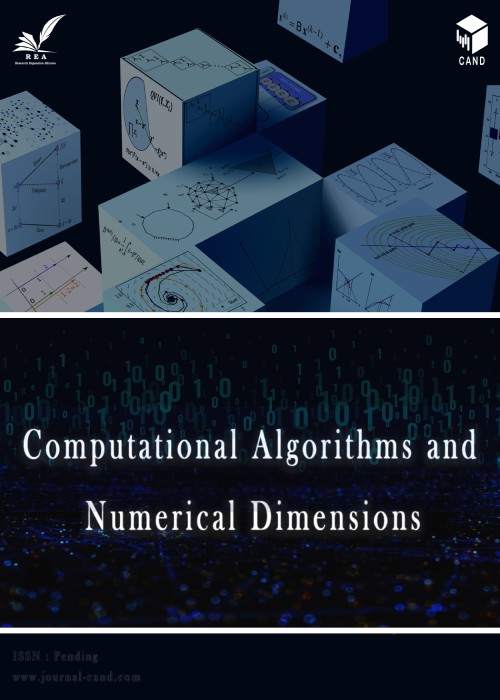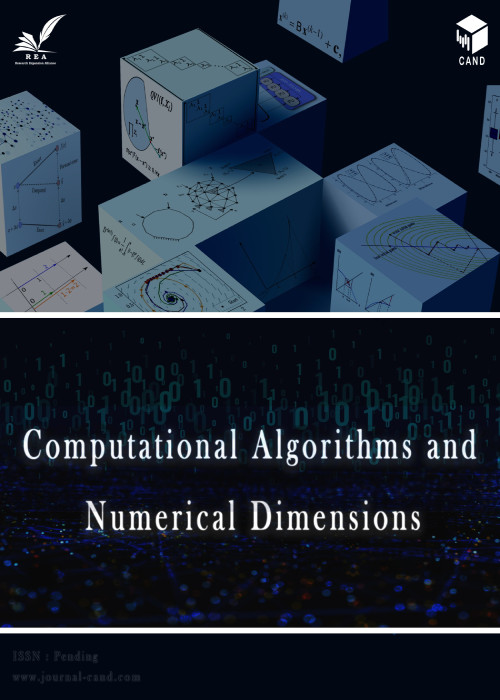فهرست مطالب

Journal of Computational Algorithms and Numerical Dimensions
Volume:2 Issue: 1, Winter 2023
- تاریخ انتشار: 1402/09/15
- تعداد عناوین: 6
-
Pages 1-6Trigonometry is a part of mathematics which deals with specific functions of angles and their application, and it is studies of the dependence between the sides and angles of a triangle. The word trigonometry is associated the operations between the sides and angles of the triangles. Initially, it aimed to calculate the values of all elements of a triangle (height, centroid length, bisector, radius, area and angles) using data sufficient to determine the triangle. In the paper, trigonometric functions are defined, and some statements about trigonometric identities are stated and proved.Keywords: Mathematics, Trigonometric functions, Trigonometric identities
-
Pages 7-11Nowadays, we know that wireless sensor networks are being widely applied in many fields of human life such as civil and military applications. Wireless Sensor Networks (WSNs) are broadly applied for various applications in tracking and surveillance due to their ease of use and other distinctive characteristics compelled by real-time cooperation among the sensor nodes. when applying the WSN in the real world we have to face many challenges such as security, storage due to its centralized server/client models. Although WSNs can bring a lot of benefits and conveniences. This paper discusses an in-depth survey of a blockchain-based approach for malicious node detection, an exhaustive examination of the integration of blockchain techniques with WSNs (BWSN), and insights into this novel concept.Keywords: Blockchain technology, malicious node detection, Security issues, Centralized
-
Pages 12-16The most energy consumption in smart domestic network is smart plugs because of an uninterrupted supply. Consequently, this studies article accommodates about home automation electricity management that indicates the balance strength consumption between the gadgets in a regular c program language period. Also, this research article presents future project duties in protection troubles in smart home surroundings. Additionally, the belief for smart home surroundings focuses the Interoperability, Reliability, Integration of clever houses and term privacy in context, term safety and privacy vulnerabilities to smart domestic. The energy may be decreased in the direction of inexperienced surroundings. Furthermore, the studies paper is considering the evaluation of calculate the terrible outcomes in environment because of complete home automation system. While calculating these bad results, the life Cycle evaluation (LCA) ought to be in sum general. This study makes use of two analyses the strength intake for environment effect of home strength management device (HEMs). The research article discusses home automation gadget consumes the strength for special devices linked for smart home.Keywords: HEMS, IoT, Water, monitoring
-
Pages 17-22Wireless Sensor Networks are considered to be among the most rapidly evolving technological domains thanks to the numerous benefits that their usage provides. As a result, from their first appearance until the present day, Wireless Sensor Networks have had a continuously growing range of applications. The purpose of this article is to provide an up-to-date presentation of both traditional and most recent applications of Wireless Sensor Networks and hopefully not only enable the comprehension of this scientific area but also facilitate the perception of novel applications. In order to achieve this goal, the main categories of applications of Wireless Sensor Networks are identified, and characteristic examples of them are studied. Their particular characteristics are explained, while their pros and cons are denoted. Next, a discussion on certain considerations that are related with each one of these specific categories takes place. Finally, concluding remarks are drawn.Keywords: Wireless sensors, domestic, hostile, applications
-
Pages 23-34
Network security is paramount in safeguarding the integrity of computer networks and the data they host. The primary objective of network security is to protect data from cyber-attacks and ensure the overall reliability of the network. A robust network security strategy deploys various solutions to shield data within networks, safeguarding both users and organizations from potential threats. This paper introduces a novel approach to evaluating computer network security using Data Envelopment Analysis (DEA), a mathematical method designed to measure the performance of Decision-Making Units (DMUs) employing identical inputs to yield identical outputs. We present a practical application of DEA to assess the security of 10 distinct networks, treating them as DMUs. The resulting performance measurements allow us to classify computer network security into four levels: "terribly insecure," "insecure," "safe," and "very safe. To optimize the discriminating power of DEA, we employ Principal Component Analysis (PCA) to reduce the number of inputs and outputs. It not only enhances the precision of our evaluation but also ensures that the number of DMUs remains well-suited to the analysis. As a rule of thumb, the number of DMUs should be at least three times larger than the sum of the numbers of inputs and outputs to maintain DEA's discriminating power. Through the combined application of DEA and PCA, this research contributes a comprehensive and efficient method for evaluating and classifying computer network security, providing valuable insights for enhancing overall network resilience against cyber threats.
Keywords: Data envelopment analysis, Principal component analysis, Computer network security, Decision-making unit -
Pages 35-46
This paper presents a Localized Radial Basis Functions Collocation Method (LRBFCM) for numerically solving one and 2-dimensional Fractional Integral Equations (2D-FIEs). The LRBFCM approach decomposes the main problem into several local sub-problems of small sizes, effectively reducing the ill-conditioning of the overall problem. By employing the collocation approach and utilizing the strong form of the equation, the proposed method achieves efficiency. Additionally, the matrix operations only require the inversion of small-sized matrices, further contributing to the method's efficiency. To demonstrate the effectiveness of the LRBFCM, the paper provides test problems encompassing linear, nonlinear, Volterra, and Fredholm types of Fractional Integral Equations (FIEs). The numerical results showcase the efficiency of the proposed method, validating its performance in solving various types of FIEs.
Keywords: Fractional calculus, Local meshless methods, Fractional integral equations, Collocation methods


